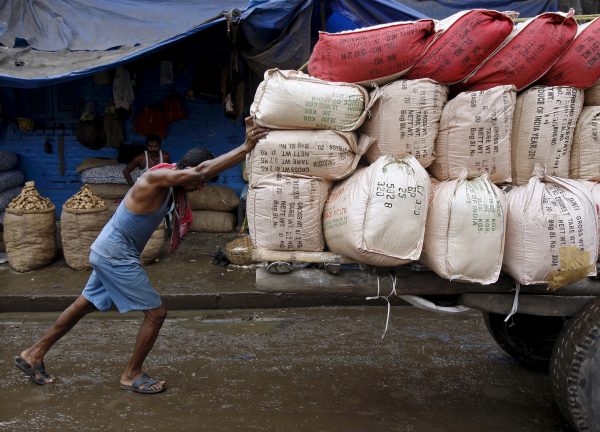During the 2000s, India experienced the most sustained periods of rapid growth in its economic history, averaging almost 9 per cent annually between 2003–11. In the same period, the proportion of the population in poverty fell from 37.2 per cent to 21.9 per cent, pulling 137.4 million people out of poverty. This growth trend has encouraged IMF optimism. The IMF projects an annual growth rate of 7.5 per cent in 2016–17.
But there remains a widespread perception in India, backed by considerable evidence, that the benefits of faster GDP growth are being undermined by a pro-rich bias. Inequality measures reveal a widening gap between rich and poor. Estimates of the Gini coefficient show an increase in consumption inequality from 0.30 in 1993–94 to 0.359 in 2011–12. Similarly, in 2013–14, the average per capita income of the top quintile was almost 11 times that of the bottom quintile.
Increasing inequality reveals two key concerns about India’s growth model. First, while growth helps reduce poverty, it may not reduce poverty quickly enough. In the period 2004–12, the average annual decline in the poverty rate, at 2.18 per cent, was significantly lower than the average annual growth rate of 8 per cent.
Second, growth is disproportionately increasing the incomes of the well-to-do. In India, the share of wages in the net value added by industries has shown a decline in the 30 years since 1983, while the share of profits has climbed. This is largely due to labour market rigidities that drive a wedge between GDP and employment growth.
Unlike China, India bypassed labour-intensive growth driven by manufacturing in favour of a services-led model. While the services sector contributed enormously to growth in the last decade, its share in employment, at 25 per cent, is less than half its share of GDP. The shortcomings of India’s growth composition have thus resulted in relatively fewer opportunities for productive employment for India’s poor.
India needs to boost manufacturing growth and absorb more workers to realise the principal intent underlying the ‘Make in India’ initiative. If India is to make manufacturing a major source of jobs, recognised impediments to doing business — infrastructure and regulatory bottlenecks, land acquisition and environmental clearances — need to be addressed.
India will also need to ease labour regulations, which are unintentionally leading to increasing numbers of contract and informal workers. Studies suggest that Indian states with more flexible labour regulations witnessed stronger growth in manufacturing employment than states with more inflexible regulations. Of course, labour regulations are not solely to blame. Yet, along with other reform measures, labour law flexibility could help India to take advantage of the space being vacated by Chinese firms due to rising costs. Much of this action needs to be taken at the state level, since the functioning of labour markets is fundamentally determined by individual states.
Given India’s limited social safety nets, well-designed fiscal policies are also vital. India confronts two distinct yet related challenges. The first challenge is to increase public social spending, and the second, to better target that spending. Importantly, the IMF has shown that this can be done without restraining the wealth-creating potential of economic growth.
Allocations for social infrastructure — including health and education — have recently increased, but remain well below Chinese levels. The World Bank estimates suggest that while China spent 3.1 per cent of its GDP on public health expenditures in 2014, India was far lower at 1.4 per cent. If India is to reap the benefits of its demographic bulge, it must increase investment in social infrastructure to improve educational and health outcomes. Better-targeted policies will also be crucial. Currently only 50 per cent of expenditure reaches the intended beneficiaries, thanks to poorly targeted policies and leakages.
Technology offers some hope. In the mid-2000s, India embarked on an ambitious financial inclusion agenda to ensure universal coverage of all households by financial institutions under the Prime Minister’s People Money Scheme (Jan-Dhan Yojana, PMJDY). One year after its launch, more than 210 million bank accounts had been opened, utilising a network of more than 100,000 business correspondents and other last-mile intermediaries.
With a bank account, every household could potentially now access banking and credit facilities and participate in the formal financial system. A biometric identity system called e-Aadhaar, after the 12-digit unique identity number issued by the government for all residents in India, is envisaged as the sole proof of identification. It will serve as the backbone for Direct Benefit Transfers linked to bank accounts, which can make income transfers predictable and targeted. Combined with mobile money, this will provide an opportunity to resolve accessibility problems that have plagued India’s formal financial institutions for decades.
The so-called JAM Number Trinity — Jan-Dhan Yojana (the PMJDY), Aadhaar and Mobile numbers — might well transform social welfare schemes. There are already indications that payments under the rural employment program through Aadhaar-linked bank accounts have increased efficiency and reduced leakages.
Building long-run fiscal capacity is going to be vital for India to meet its development challenges, including financial inclusion. Growth has helped shore up total tax revenues. Yet India still undertaxes and underspends, especially on social infrastructure. India stands to benefit immensely from an efficient and non-adversarial tax regime. This would not only strengthen and legitimise the sovereign function of government, but would also bolster revenue collections that enable government to intervene to achieve more equity in the distribution of income. That, along with measures to support more inclusive growth, will ensure that as India grows it does not leave the poor behind.
Rajat Kathuria is the Director and Chief Executive Officer of the Indian Council for Research on International Economic Relations (ICRIER).
An extended version of this article first appeared here, at Global Asia.

